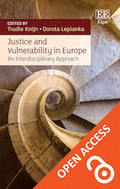
 Rights, progress and efficiency come together in the narrative over which the European Union (EU) was built. However, there is a growing aware-ness on the faultiness and mechanisms that still limit access to justice and the deepening and strengthening of social justice in the European project, as the ETHOS project sought to address (see Chapter 1). High expenditure on social protection, when compared with other realities, grounded on the principles of solidarity, equality and social cohesion represent the soul of the EU (Vaughan-Whitehead 2015). The European Social Model (ESM) was con-ceived as a unifying and protective umbrella that should strengthen the rather fragile European identity, distinguish Europe from North America and provide tools to protect citizens from uncontrolled neoliberalism (Hermann 2017).There are multiple expressions of how the EU project has deviated from its initial objectives. Cuts in social policies, youth unemployment and precarious-ness, the increasing of inequalities and social exclusion, the narrative of the inevitability of welfare state retrenchment and the democratic deficit are some of the signs. At the core of this chapter is the idea that European welfare and employment regimes are experiencing a convergence towards neoliberalism with nefarious results for distribution and social justice, with an extra burden being placed on families in which women play a significant role. Defined as ‘a political project that is justified on philosophical grounds and seeks to extend competitive market forces, consolidate a market-friendly constitution, and promote individual freedom’ (Jessop 2013, p. 70), the ongoing neoliberal policies have dangerous consequences for democracy and citizenship that are here addressed with a focus on gender inequality in the workplace, women’s resistances and alternative projects. >READ FULL CHAPTER
Rights, progress and efficiency come together in the narrative over which the European Union (EU) was built. However, there is a growing aware-ness on the faultiness and mechanisms that still limit access to justice and the deepening and strengthening of social justice in the European project, as the ETHOS project sought to address (see Chapter 1). High expenditure on social protection, when compared with other realities, grounded on the principles of solidarity, equality and social cohesion represent the soul of the EU (Vaughan-Whitehead 2015). The European Social Model (ESM) was con-ceived as a unifying and protective umbrella that should strengthen the rather fragile European identity, distinguish Europe from North America and provide tools to protect citizens from uncontrolled neoliberalism (Hermann 2017).There are multiple expressions of how the EU project has deviated from its initial objectives. Cuts in social policies, youth unemployment and precarious-ness, the increasing of inequalities and social exclusion, the narrative of the inevitability of welfare state retrenchment and the democratic deficit are some of the signs. At the core of this chapter is the idea that European welfare and employment regimes are experiencing a convergence towards neoliberalism with nefarious results for distribution and social justice, with an extra burden being placed on families in which women play a significant role. Defined as ‘a political project that is justified on philosophical grounds and seeks to extend competitive market forces, consolidate a market-friendly constitution, and promote individual freedom’ (Jessop 2013, p. 70), the ongoing neoliberal policies have dangerous consequences for democracy and citizenship that are here addressed with a focus on gender inequality in the workplace, women’s resistances and alternative projects. >READ FULL CHAPTER